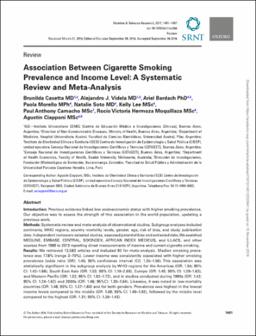| dc.description.abstract | INTRODUCTION:
Previous evidence linked low socioeconomic status with higher smoking prevalence. Our objective was to assess the strength of this association in the world population, updating a previous work.
METHODS:
Systematic review and meta-analysis of observational studies. Subgroup analyses included continents, WHO regions, country mortality levels, gender, age, risk of bias, and study publication date. Independent reviewers selected studies, assessed potential bias and extracted data. We searched MEDLINE, EMBASE, CENTRAL, SOCINDEX, AFRICAN INDEX MEDICUS, and LILACS, and other sources from 1989 to 2013 reporting direct measurements of income and current cigarette smoking.
RESULTS:
We retrieved 13,583 articles and included 93 for meta-analysis. Median smoking prevalence was 17.8% (range 3-70%). Lower income was consistently associated with higher smoking prevalence (odds ratio [OR]: 1.45; 95% confidence interval [CI]: 1.35-1.56). This association was statistically significant in the subgroup analysis by WHO regions for the Americas (OR: 1.54; 95% CI: 1.42-1.68), South East Asia (OR: 1.53; 95% CI: 1.10-2.00), Europe (OR: 1.45; 95% CI: 1.29-1.63), and Western Pacific (OR: 1.32; 95% CI: 1.02-1.72), and in studies conducted during 1990s (OR: 1.42; 95% CI: 1.24-1.62) and 2000s (OR: 1.48; 95%CI: 1.30-1.64). Likewise, it was noted in low-mortality countries (OR: 1.48; 95% CI: 1.37-1.60) and for both genders. Prevalence was highest in the lowest income levels compared to the middle (OR: 1.69; 95% CI: 1.49-1.92), followed by the middle level compared to the highest (OR: 1.31; 95% CI: 1.20-1.43).
CONCLUSIONS:
Our results show that current cigarette smoking was significantly associated with lower income worldwide and across subgroups, suggesting a dose-response relationship.
IMPLICATIONS:
This unique updated systematic review shows a consistent inverse dose-response relationship between cigarette smoking and income level, present among most geographical areas and country characteristics. Public health measures should take into account this potential inequity and consider special efforts directed to disadvantaged populations. | en_US |


